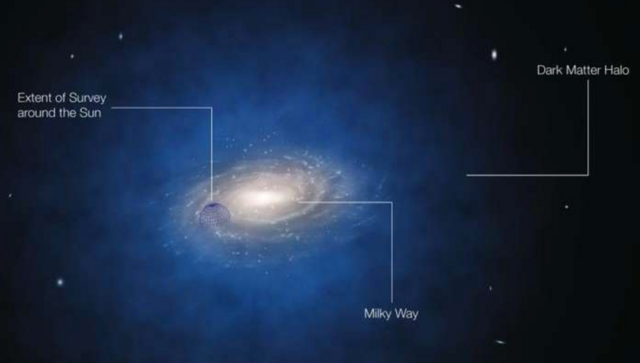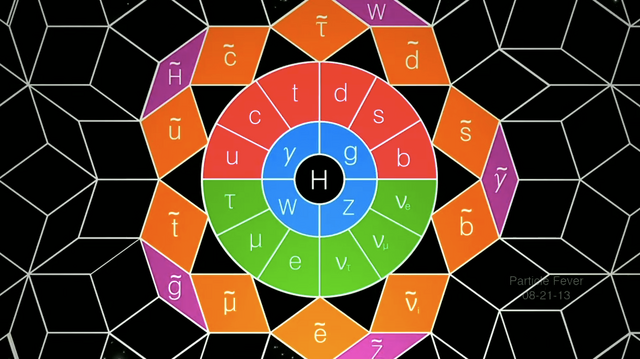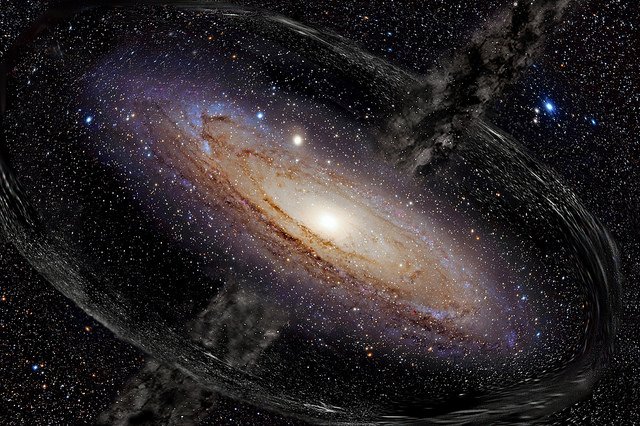About my own research - resurrecting an old dark matter option
I am currently involved in the study of various dark matter models that aim to accommodate both cosmological and collider data simultaneously. The microscopic world is indeed very connected to cosmology, and both actually speak with each other.
 [image credits: Gtsourdinis (CC BY-SA 4.0)]
[image credits: Gtsourdinis (CC BY-SA 4.0)] In a recent article, I have investigated, together with my collaborators, a specific class of models extending the Standard Model of particle physics.
Those models, called LND models, feature dark matter, are motivated by the unification of the fundamental interactions and additionally fix several other limitations of the Standard Model, like the masses of the neutrinos.
In terms of dark matter, they in fact exhibit an option that is generally thought of as non reasonable with respect to existing data. Moreover, although this option is currently allowed by data, the dark matter experiments of the next decade will be able to fully rule it out, together with the future results of the Large Hadron Collider, the LHC at CERN.
GOING BEYOND THE STANDARDS: SUPERSYMMETRY
Although highly tested for decades, the Standard Model of particle physics is incomplete and should be extended. This is the core reason why new phenomena in particle physics are expected: one needs a solution to the conceptual issues and practical limitations of the Standard Model.
Supersymmetry consists in one of these, solving several problems of the Standard Model in one shot.

[image credits: CERN]
Supersymmetry is a potential symmetry of nature in which each of the Standard Model particles is connected to partners of different spin, also known as superpartners.
I recall that the spin is a property of any particle and consists in its intrinsic angular momentum.
I will not spend much time on superymmetry (please see here for more information), but I will instead solely mention that the most minimal supersymmetric theory brings already a lot.
Supersymmetry first stabilizes the Higgs boson with respect to quantum corrections (the microscopic world is quantum). The masses of the Higgs boson and the mediators of the fundamental interactions are what they are, and this makes the Standard Model very un-natural as its parameters must be tuned up to their 30th decimal to avoid issues. The presence of the superpartners allows one to automatically kill any issue brought by the corresponding Standard Model particle.
Moreover, the lightest superpartner can in general be a potential candidate for explaining the problematics of dark matter and many supersymmetric models feature the grand unification of all fundamental interactions.
LND SUPERSYMMETRY: GIVING UP MINIMALITY BUT NOT UNIFICATION
Supersymmetry has however not been found so far, so that it may be hiding better than originally thought of. One potential reason is that most searches for supersymmetry assume that it is minimal (all superpartners are those shown below).

[image credits: CERN (but cannot find where anymore)]
However, why should nature be minimal? Whilst minimality is elegant, there is no good reason behind it.
In my work, we have investigated one supersymmetric option where one gives up minimality whilst preserving the unification of the fundamental interactions.
It is called LND supersymmetry, as the model particle content is extended by new heavy Leptons, Neutrinos and Down-type quarks.
Existing data does not allow to extend the model arbitrarily. However, LND supersymmetry offers us a way to do so in a way explaining why we have not observed anything at the LHC, but also why neutrinos are massive (that is one of the shortcomings of minimal supersymmetry).
And here comes dark matter: LND supersymmetry turns out to be additionally compatible with cosmology.
LND DARK MATTER
Standard cosmology features that the dynamics of the universe is ruled by dark matter.

[image credits: Maxwell Hamilton (CC BY 2.0)]
Dark matter is an invisible substance that interacts gravitationally.
It explains the circular motion of stars around the galactic centers with classical mechanics, the properties of the cosmic microwave background (the radiation left over from the big bang), the formation of the large structures in the universe and much more.
But dark matter has not been observed so far, even if it consists in the most hunted stuff of the universe.
LND supersymmetry features more than 3 neutrinos, which is necessary to explain the masses of the neutrinos. All of those new neutrinos however have superpartners, so that the lightest of them could potentially be a novel option for dark matter that is weird enough to have escaped detection up to now.
TAKE-HOME MESSAGE - SNEUTRINO DARK MATTER
In the LND model we studied, we have abandoned minimality. It is not only allowed by data but we can also explain why neutrinos are massive. In the LND setup, this is however done in a way preserving the unification of all fundamental interactions. One of the consequent LND novelties is that we can have sneutrino dark matter, where sneutrinos are the supersymmetric partners of the neutrinos.
This consists in the main difference with other scenarios: in general, sneutrino dark matter is excluded by the observations. In our work, we have shown that LND sneutrino dark matter is allowed. We can both reproduce the measured dark matter abundance in the universe and explain why dark matter has not been observed in direct detection experiments and in cosmic rays.
We have also demonstrated that LND sneutrino dark matter will be deeply probed within the next 10 years thanks to the expected advances in dark matter experiments. Another fun fact is that the LND model also features an extra charged lepton (a fat big brother of the electron) that could be more or less easily found at the LHC.
In other words, this model is appealing because it provides an explanation to current data and is as well testable on a very short term. In a few words, it will either be discovered or excluded.
STEEMSTEM
SteemSTEM aims to build a community of science lovers to make Steem a better place for Science Technology Engineering and Mathematics (STEM). We have recently released our own app, steemstem.io (for which a dev is looked for), and we run a witness and a seed node (seed.steemstem.io:2001) to support the Steem blockchain.
More information can be found on the @steemstem blog (here for the latest news) and on our discord server.
We are on our way to make Steem a crucial medium for science communication, and it is still time to contribute to this effort! If you want to support us (and get some incentives for it), this is also possible.
I like this way of putting it, and the alliterative 'c' at the beginning of both words!
What do you mean by practical limitations?
Why did you give such a puny name (variously meaning 'thin' 'small' 'light' etc.) to something heavy?
The Standard Model has limitations in the sense it cannot tell us anything about dark matter, it cannot explain the masses of the neutrinos, the three fundamental interaction strengths almost unify at high energies (but they just miss each other instead), etc... There are many hints of "this could not be the end of the story".
Because it is funny? :D
So, you, the dark-matter-people are actually real? :D
Oh, God, this is toooooooo complicated for me to assimilate. Lol.
However, now I can boast to my friends that I know a dark-matter-guy :D
Jokes aside. What you do is sooo interesting! I feel so small and irrelevant every time I read about cosmology :)
Cheers!
We are about to rule the world, but this is a (dark) secret ;)
I tried to make the post kind of easy to get (at least the big lines). Apparently I failed :(
You didn't. I was trying to be funny.
I knew it!
I am often too serious :D
Lol.
And I am often just trying to be funny. My jokes are very ... (hmm... I can't find a better word) ... clumsy :D
My jokes are the same, so no worries ^^
interesting article. Is there any other way to validate your hypothesis except being able to observe that symmetry in the wild?
It is not really in the wild. Supersymmetry is a very natural symmetry of nature (it arises from first principles) and is one of the most studied theory extending the Standard Model. The problem here is that many predictions are not realized in data. As a result, the mass scale of the new particles is more and more shifted towards the high energy regime. Another option is that all new particles must satisfy some specific properties that make them stealthy.
From cosmological considerations, we start to constrain models from a different angle: dark matter. As a result, the number of realistic scenarios starts to be limited, which means we can design appropriate ways to corner what is left over. Here, we investigated a class of supersymmetric models (the LND models) that can accommodate all data. But the options are limited so that the models will be reachable in a close future. If excluded, the game is not over. We can make the model further less minimal or just follow another, still supersymmetric, approach.
But in short, LND models may be excludable soon, but supersymmetry not. There are too many options. What is important is to close all potential loop holes.
I don't know whether this was clear enough. Feel free to come back to me if needed :)
That was a fascinating read. It's been quite a while since I read such a detailed article about physics. I had forgotten that some sort of yet unobserved neutrino could explain dark matter, partially or totally. Yeah I had heard that there was such a possibility. I know most people have never even heard of neutrinos.
Neutrino dark matter does not work, unfortunately. The catch here is to put ourselves in a supersymmetric framework and use the partners of the neutrinos, the sneutrinos, as a potential source of dark matter.
Will you pass by at the steemquebec meetup tonight? I will be there (I am currently visiting the family in the North as well as in Montreal for work) ;)
Dear @lemouth :)
I'm always amazed at your research and scientific findings. Never heard of "Neutrino Dark Matter"before. Indeed you are a blessing to me and #steemstem in general.
Thank you!
Actually, neutrino cannot be dark matter. This has been considered at some point, but quickly proved as not working. However, sneutrino (the superpartner of the neutrinos) can be dark matter. The initial 's' matters :)
I upvoted your post.
Keep steeming for a better tomorrow.
@Acknowledgement - God Bless
Posted using https://Steeming.com condenser site.
Thanks for the acknowledgement ;)
Congratulations @lemouth! You have completed the following achievement on the Steem blockchain and have been rewarded with new badge(s) :
Click here to view your Board of Honor
If you no longer want to receive notifications, reply to this comment with the word
STOPDo not miss the last post from @steemitboard: